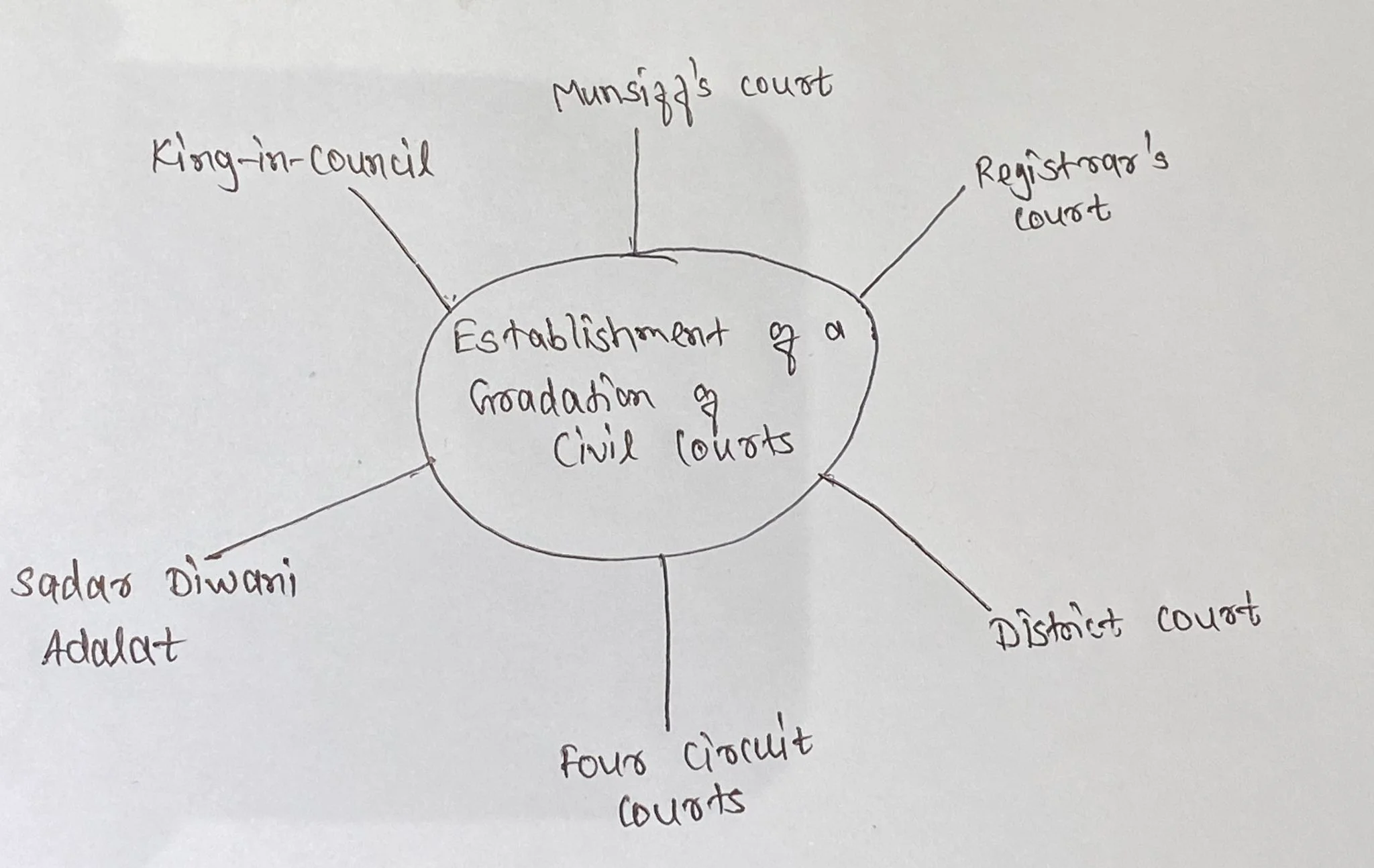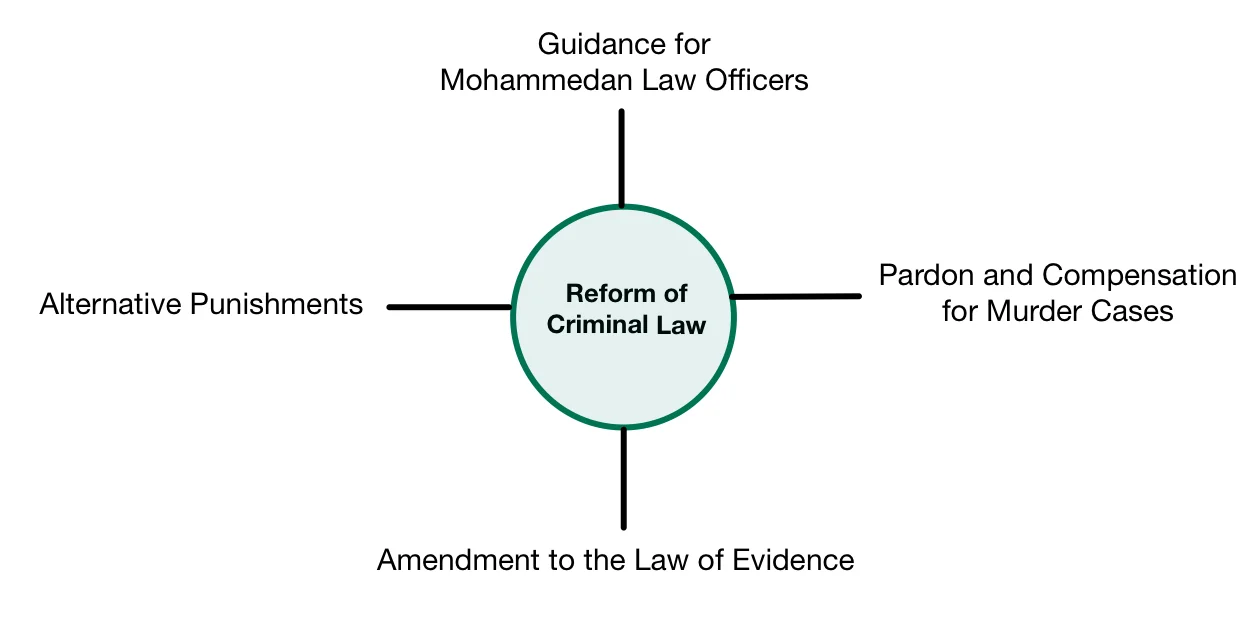In 1786, the Court of Directors appointed Lord Cornwallis, a nobleman with a distinguished background and aristocratic demeanour, to lead their efforts in India. His mission was to implement the policy of peace outlined in Pitt’s India Act and to reorganize the administrative system in the country. Cornwallis was given specific responsibilities, including finding a satisfactory resolution to the land revenue problem, establishing an honest and efficient judicial system, and reorganizing the commercial department of the East India Company. In India, Cornwallis built upon the foundations of the administrative system devised by Warren Hastings and created a superstructure that remained largely intact until 1858.
Reforms initiated during the tenure of Cornwallis (1786-1793)
Abolition of District Faujdari Courts: The District Faujdari Courts were discontinued, and in their place, circuit courts were established in Calcutta, Dacca, Murshidabad, and Patna.
- These circuit courts were presided over by European judges and served as appellate courts for both civil and criminal cases.
- These courts conducted regular trials of the districts twice a year and heard cases involving individuals committed by city magistrates.
- Relocation of Sadar Nizamat Adalat: The Sadar Nizamat Adalat was moved to Calcutta and placed under the authority of the governor-general and members of the Supreme Council, with the assistance of the chief qazi and the chief mufti.
- Transformation of District Diwani Adalat: The District Diwani Adalat was renamed as the District, City, or Zila Court and placed under the supervision of a district judge.
- The collector’s role was now limited to revenue administration, with no magisterial functions.

Enroll now for UPSC Online Course
- Establishment of a Gradation of Civil Courts: A hierarchy of civil courts was introduced, addressing both Hindu and Muslim laws, which included:
- Munsiff’s Court, managed by Indian officers.
- Registrar’s Court presided over by a European judge.
- District Court, under the jurisdiction of the district judge.
- Four Circuit Courts serve as provincial courts of appeal.
- Sadar Diwani Adalat in Calcutta.
- King-in-Council for appeals involving sums of 5,000 pounds and above.
These reforms sought to streamline and modernise the judicial system, placing more authority in the hands of the Collector, and introducing circuit courts to enhance the efficiency and effectiveness of the criminal justice system.

Introduction of the Cornwallis Code
The Cornwallis Code, implemented in 1793, represented a significant milestone in the development of the Indian judicial system. This code was based on the principle of the separation of powers, which aimed to enhance the efficiency and fairness of the administration of justice in India. Some key aspects of the Cornwallis Code included:
- Separation of Revenue and Justice Administration: Under the influence of 18th-century French philosophers, Lord Cornwallis sought to separate the revenue administration from the administration of justice.
- Collector’s Dual Role: Before these reforms, the Collector was responsible for both revenue collection and exercising extensive judicial and magisterial powers.
- This dual role created a conflict of interest, as the Collector, acting as a judge in the Diwani Adalat, was expected to address grievances related to revenue collection, which he was also responsible for.
- Separation of Judicial and Revenue Functions: The Cornwallis Code addressed this issue by divesting the Collector of all judicial and magisterial powers, focusing their role solely on revenue administration.
- Introduction of District Judges: To address the need for impartiality in the administration of justice, a new class of officers, known as District Judges, was created.
- These judges presided over the District Civil Court, which had jurisdiction over all civil cases.
- District Judges were also entrusted with magisterial and police functions, ensuring a clear separation of powers and a more equitable judicial process.
- Gradation of Civil Courts: The Cornwallis Code established a gradation of civil courts, eliminating the distinction between revenue and civil cases. This allowed the new Diwani courts to hear all civil cases.
- At the lowest level were the Munsiffs’ courts, presided over by Indian officers and competent to decide disputes involving sums up to 50 rupees.
- Next were the courts of Registrars, led by European officers, with the authority to handle cases up to 200 rupees.
- Appeals from these lower courts were directed to the District or City Courts, presided over by District Judges.
- Above these were the Provincial Courts of Appeal in Calcutta, Murshidabad, Dacca, and Patna, presided over by English judges, who also supervised the functioning of District Courts.
- The highest appellate authority was the Sadr Diwani Adalat in Calcutta, chaired by the Governor-General and his Council, which heard appeals from Provincial Courts involving disputes exceeding 1,000 rupees.
- Appeals beyond this point were sent to the King-in-Council in cases exceeding £5,000.
- Application of Laws: The Cornwallis Code stipulated that Mohammedan law applied to Muslims, and Hindu law applied to Hindus. This ensured that legal matters were handled according to the appropriate religious laws.
- Jurisdiction Over European Subjects: Even European subjects residing in the districts were made subject to the jurisdiction of local civil courts. They were required to agree to the jurisdiction of district civil courts before being granted licences to reside in districts away from Calcutta.
- Government servants were also made answerable to civil courts for actions carried out in their official capacity, reinforcing the principle of the Sovereignty of Law.
- Criminal Administration: The Cornwallis Code also brought important changes to criminal administration. District Faujdari Adalats, presided over by Indian officers, were abolished.
- The District Judge was granted magisterial powers, allowing them to order the arrest of criminals and individuals disturbing the peace. They handled petty cases themselves and transferred more serious offences to the four circuit courts.
- The provincial circuit courts of appeal, which also heard civil cases, functioned as criminal circuit courts.
- Judges of these circuit courts toured their divisions biannually and adjudicated criminal cases with the assistance of Indian Qazis and Muftis.
- These courts had the authority to issue sentences of death or life imprisonment, with confirmation required from the Sadar Nizamat Adalat, the highest court of appeal for criminal cases.
- The Governor-General held the general power of pardon or commutation of punishment.
The Cornwallis Code represented a significant effort to streamline and modernise the judicial and administrative systems in India. It aimed to promote efficiency, impartiality, and adherence to the rule of law, setting the stage for developing India’s legal framework in the years to come.
Reform of Criminal Law
Cornwallis made significant strides in reforming the criminal law in India, asserting the right of the East India Company’s government to bring about these changes. These reforms aimed to modernise the criminal justice system, which was deeply rooted in religious and traditional practices, particularly among the Muslim population.
Some of the key reforms in criminal law introduced during 1790-93, and later regularised by a Parliamentary Act of 1797, were as follows:
- Guidance for Mohammedan Law Officers: In December 1790, a rule was established to guide Mohammedan law officers in their handling of murder trials.
- The Intent of the Perpetrator Over the Method: According to this rule, in cases of murder, the focus should be on the intention of the murderer, whether it is evident or fairly inferable, rather than the specific manner or instrument used in the act.
- Legal Shift: This represented a shift away from a strict reliance on the method of perpetration and emphasised the importance of establishing the perpetrator’s intent.

- Pardon and Compensation for Murder Cases: Another significant change was introduced in cases of murder. The will of the heir or kindred of the deceased was no longer allowed to influence the grant of pardon or the demand for compensation money, which was traditionally considered a blood price.
- This reform aimed to remove potential biases and ensure that justice was administered more impartially.
- Alternative Punishments: Instead of the traditional punishment of amputation of limbs or body parts, Cornwallis’s reforms replaced it with a system of temporary hard labour, fines, or imprisonment, depending on the circumstances of the case.
- This change sought to introduce a more humane and practical approach to criminal punishment.
- Amendment to the Law of Evidence: Regulation IX of 1793 amended the law of evidence by stating that the religious persuasions of witnesses should not be considered a bar to the conviction or condemnation of a prisoner.
- This change was significant because it allowed non-Muslim witnesses to testify against Muslims in criminal cases, which had not been permitted under traditional Muslim law of evidence.
- This reform aimed to ensure that all relevant evidence was considered in criminal proceedings, irrespective of the religious background of the witnesses.
Observations on Judicial Reforms
The judicial reforms implemented under Cornwallis, based on principles of equity and Western conceptions of justice, marked a significant departure from traditional, religious-based legal systems. The Cornwallis Code introduced codified secular laws to replace the religious or personal laws of rulers or local agents. The principle of the sovereignty of law was clearly articulated, and even government officials were made accountable in the courts for their actions in their official capacities.
However, while these reforms held great potential for establishing a more equitable and just legal system, they also had some challenges.
- Complexity and Inaccessibility: The Cornwallis Code, with its novel, unfamiliar, and elaborate legal framework, was so complicated that it became difficult for the common person to understand and navigate.
- The complexity of the legal system made it challenging for ordinary individuals to access and benefit from justice.
- Expensive Justice: The pursuit of justice under the Cornwallis Code became an expensive affair. It provided opportunities for individuals with financial means to exploit and wear down the uneducated and impoverished.
- The costs associated with legal proceedings often placed justice beyond the reach of many.
- False Witnesses and Deceit: The complicated legal system created opportunities for false witnesses and dishonest practices.
- Falsehood, chicanery, and deceit became more common, undermining the integrity of the legal process.
- Increased Litigation: The Cornwallis Code led to a significant increase in litigation. The law courts became inundated with cases, making it difficult for them to keep up with the growing workload.
- This resulted in considerable delays in the resolution of legal matters.
- Lack of Cultural Understanding: One of the significant challenges was that traditional judicial functionaries like Panchayats, Zamindars, Qazis, and Faujdars, who knew local customs and habits, were replaced by European judges who often lacked a deep understanding of Indian culture and traditions.
Enroll now for UPSC Online Course
-
- This gap in cultural awareness could lead to judgments that did not fully consider the local context.
| Must Read | |
| Current Affairs | Editorial Analysis |
| Upsc Notes | Upsc Blogs |
| NCERT Notes | Free Main Answer Writing |
Conclusion
The judicial reforms under Cornwallis introduced a modern, efficient legal framework in India, promoting the separation of judicial and revenue functions. The Cornwallis Code, while revolutionary, aimed to create impartiality and justice based on Western principles. However, it faced challenges like complexity, increased litigation, and the cultural disconnect of European judges. Despite these issues, the reforms laid the groundwork for the future development of India’s judicial system, marking a significant step toward modernization.
Sign up for the PWOnlyIAS Online Course by Physics Wallah and start your journey to IAS success today!
| Related Articles | |
| ADVENT OF EUROPEANS: CAUSES AND IMPACTS | Pitt’s India Act 1784 |
| Exploring the Indian Judiciary: Structure, Significance, & Rule of Law | Lord Cornwallis (1786–1793) |

 GS Foundation
GS Foundation Optional Course
Optional Course Combo Courses
Combo Courses Degree Program
Degree Program











